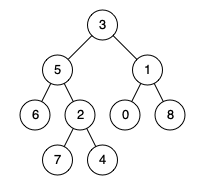| comments | difficulty | edit_url | tags | ||||
|---|---|---|---|---|---|---|---|
true |
Medium |
|
Given two nodes of a binary tree p and q, return their lowest common ancestor (LCA).
Each node will have a reference to its parent node. The definition for Node is below:
class Node {
public int val;
public Node left;
public Node right;
public Node parent;
}
According to the definition of LCA on Wikipedia: "The lowest common ancestor of two nodes p and q in a tree T is the lowest node that has both p and q as descendants (where we allow a node to be a descendant of itself)."
Example 1:
Input: root = [3,5,1,6,2,0,8,null,null,7,4], p = 5, q = 1 Output: 3 Explanation: The LCA of nodes 5 and 1 is 3.
Example 2:
Input: root = [3,5,1,6,2,0,8,null,null,7,4], p = 5, q = 4 Output: 5 Explanation: The LCA of nodes 5 and 4 is 5 since a node can be a descendant of itself according to the LCA definition.
Example 3:
Input: root = [1,2], p = 1, q = 2 Output: 1
Constraints:
- The number of nodes in the tree is in the range
[2, 105]. -109 <= Node.val <= 109- All
Node.valare unique. p != qpandqexist in the tree.
We use a hash table
The time complexity is
"""
# Definition for a Node.
class Node:
def __init__(self, val):
self.val = val
self.left = None
self.right = None
self.parent = None
"""
class Solution:
def lowestCommonAncestor(self, p: "Node", q: "Node") -> "Node":
vis = set()
node = p
while node:
vis.add(node)
node = node.parent
node = q
while node not in vis:
node = node.parent
return node/*
// Definition for a Node.
class Node {
public int val;
public Node left;
public Node right;
public Node parent;
};
*/
class Solution {
public Node lowestCommonAncestor(Node p, Node q) {
Set<Node> vis = new HashSet<>();
for (Node node = p; node != null; node = node.parent) {
vis.add(node);
}
for (Node node = q;; node = node.parent) {
if (!vis.add(node)) {
return node;
}
}
}
}/*
// Definition for a Node.
class Node {
public:
int val;
Node* left;
Node* right;
Node* parent;
};
*/
class Solution {
public:
Node* lowestCommonAncestor(Node* p, Node* q) {
unordered_set<Node*> vis;
for (Node* node = p; node; node = node->parent) {
vis.insert(node);
}
for (Node* node = q;; node = node->parent) {
if (vis.count(node)) {
return node;
}
}
}
};/**
* Definition for Node.
* type Node struct {
* Val int
* Left *Node
* Right *Node
* Parent *Node
* }
*/
func lowestCommonAncestor(p *Node, q *Node) *Node {
vis := map[*Node]bool{}
for node := p; node != nil; node = node.Parent {
vis[node] = true
}
for node := q; ; node = node.Parent {
if vis[node] {
return node
}
}
}/**
* Definition for a binary tree node.
* class Node {
* val: number
* left: Node | null
* right: Node | null
* parent: Node | null
* constructor(val?: number, left?: Node | null, right?: Node | null, parent?: Node | null) {
* this.val = (val===undefined ? 0 : val)
* this.left = (left===undefined ? null : left)
* this.right = (right===undefined ? null : right)
* this.parent = (parent===undefined ? null : parent)
* }
* }
*/
function lowestCommonAncestor(p: Node | null, q: Node | null): Node | null {
const vis: Set<Node> = new Set();
for (let node = p; node; node = node.parent) {
vis.add(node);
}
for (let node = q; ; node = node.parent) {
if (vis.has(node)) {
return node;
}
}
}We can use two pointers
The time complexity is
"""
# Definition for a Node.
class Node:
def __init__(self, val):
self.val = val
self.left = None
self.right = None
self.parent = None
"""
class Solution:
def lowestCommonAncestor(self, p: 'Node', q: 'Node') -> 'Node':
a, b = p, q
while a != b:
a = a.parent if a.parent else q
b = b.parent if b.parent else p
return a/*
// Definition for a Node.
class Node {
public int val;
public Node left;
public Node right;
public Node parent;
};
*/
class Solution {
public Node lowestCommonAncestor(Node p, Node q) {
Node a = p, b = q;
while (a != b) {
a = a.parent == null ? q : a.parent;
b = b.parent == null ? p : b.parent;
}
return a;
}
}/*
// Definition for a Node.
class Node {
public:
int val;
Node* left;
Node* right;
Node* parent;
};
*/
class Solution {
public:
Node* lowestCommonAncestor(Node* p, Node* q) {
Node* a = p;
Node* b = q;
while (a != b) {
a = a->parent ? a->parent : q;
b = b->parent ? b->parent : p;
}
return a;
}
};/**
* Definition for Node.
* type Node struct {
* Val int
* Left *Node
* Right *Node
* Parent *Node
* }
*/
func lowestCommonAncestor(p *Node, q *Node) *Node {
a, b := p, q
for a != b {
if a.Parent != nil {
a = a.Parent
} else {
a = q
}
if b.Parent != nil {
b = b.Parent
} else {
b = p
}
}
return a
}/**
* Definition for a binary tree node.
* class Node {
* val: number
* left: Node | null
* right: Node | null
* parent: Node | null
* constructor(val?: number, left?: Node | null, right?: Node | null, parent?: Node | null) {
* this.val = (val===undefined ? 0 : val)
* this.left = (left===undefined ? null : left)
* this.right = (right===undefined ? null : right)
* this.parent = (parent===undefined ? null : parent)
* }
* }
*/
function lowestCommonAncestor(p: Node | null, q: Node | null): Node | null {
let [a, b] = [p, q];
while (a != b) {
a = a.parent ?? q;
b = b.parent ?? p;
}
return a;
}